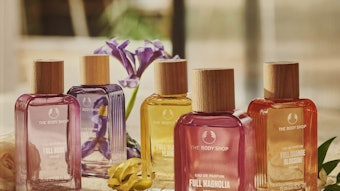“Take it with a grin of salt.”
—Yogi Berra
Compared to all the high-tech ingredients stealing the cosmetic spotlight, salt might seem a comparatively drab commodity item, but it has played a key role in the story of mankind, as has been expertly depicted in Mark Kurlansky’s Salt: A World History1. Salt funded the Erie Canal and the Great Wall of China. Gandhi’s salt march of 1930 led to independence for India. Salt has also given sauerkraut and olives to the global gastronomy. Salt is not only an essential cosmetic ingredient, but one that is still undergoing technical refinements and novel applications.
The Chemistry of Salt
In elementary chemistry, when acids and bases react, they form a salt and water. This is called a neutralization reaction:
HA + BOH —> BA + H2O.
By far the most common salt is sodium chloride, NaCl, but many other salts find use in personal care. Many raw materials contain significant quantities of salt. Commercial cocamidopropyl betaine is 35% solids, but only 30% surfactant. The difference between solids and actives is 5% NaCl. Disodium cocamphodiacetate is 40% surfactant, 10% NaCl. Many surfactants, such as ammonium lauryl sulfate, come in different viscosity grades, with salt content being one key variable.
Salt is usually a cubic crystal with alternating sodium and chlorine ions. The presence of even a slight amount of moisture will cause the salt to dissolve and the crystals to stick together. Caking affects flow and makes some processes less efficient, and additives have been used to alleviate the problem. But even the shape of a salt crystal is subject to the march of technology. A new shape has recently been developed by researchers in India2 to reduce these caking effects. The addition of a small amount of glycine changes the shape from cubic to a decahedron, which is nearly spherical. This shape has much better flow. In addition, glycine is more resistant to water, so humid conditions have less effect on the crystals.
Glycine is costly, but a significant portion can be recycled. The final product has 0.5–1.0% glycine, which is an essential amino acid and imparts a slight refreshing and sweet flavor. As a bonus, the aqueous solutions are clear—whereas traditional anti-caking agents create cloudy solutions.
Salt’s Added Value
The most extensive use of sodium chloride is viscosity control. Surfactant micelles assume a larger effective volume by associating with added salt. This effective swelling of micelles increases viscosity. This goes only so far before additional salt causes the micelles to split. The process is routinely tracked by a graph called the salt curve. Wise formulators keep the salt adjustment to the left side of the peak so that a precipitous drop in viscosity will not occur if a mistake is made.
Salt is not often found in emulsions, but it can have value in w/o emulsions. The salt will increase in polarity in the internal phase, pulling more of the hydrophilic end of the emulsifier into the water. This process helps reduce the interfacial tension. Salt typically destabilizes conventional o/w emulsions.
Salt comes into its own as a primary ingredient in scrubs and bath soaks. In scrubs, it is an abrasive, but the soaks lead to an unexpected area of science—diffusion and osmotic pressure.
Skin gets wrinkly when submerged in water, but this does not happen in concentrated salt water. The solute concentration in skin cells is greater than that of tap water; thus water will flow into the cells in an attempt to equalize the concentration. This excess water makes the skin wrinkle. The solute concentration of salt water is greater than that in the cells, so water will leave the skin, making it tighter. That is how bath salts, used in adequate quantities, work.
Dendritic salt is crystallized with a trace of yellow prussate of soda, producing star-shaped crystals. The micropores created by this structure have superior absorbance, and can hold relatively high levels of essential oils. The purity of the crystal also increases the oxidative stability of bound oils; thus it can be a good carrier for fragranced products.
Salt and the Sea
The ocean is composed of “salt water.” If the salt in the sea could be removed and spread evenly over the Earth’s land surface, it would form a layer more than 500 feet thick—about the height of a 40-story office building. Hippocrates, the father of medicine, was the first to discover the therapeutic virtues of seawater by observing the beneficial effects it had on the injured hands of a fisherman. Prompted by the fact that contact with seawater restricted infection risks, he encouraged his patients to follow treatments involving its use. The contemporary process, called thalassotherapy (from the Greek, meaning “treat with the sea”), claimed to be an effective treatment for the rejuvenation of cells. The fresh heated seawater is presumed to induce an exchange of minerals and toxins between the blood and water.
The ocean is approximately 3.5% salts, of which about 2.6% is sodium chloride. The Dead Sea, on the other hand, is an entirely different entity. The salt levels there are an amazing 27%. The greatest difference is in the relative sodium content. Many beneficial claims have been made for the specific composition of Dead Sea salts, mostly due to nonsodium components such as magnesium and bromine, dating back thousands of years. Galen, for example, promoted the salts for the treatment of rheumatism 2000 years ago.
Marketing Discoveries
Despite the high praise for Dead Sea salts, cosmetic marketers have moved on to discover the wonders of bamboo salt and Himalayan crystal salt. Bamboo salt is made by roasting sea salt in bamboo cylinders plugged with yellow mud. It is used in traditional Korean medicine as an antibacterial product, a counteraction to poison and aid to the immune system. Lest thou art skeptical, serious literature3,4 attests its therapeutic claims, such as the control of certain allergic reactions.
Bamboo salt yields nothing to the ultimate in exotic varieties—Himalayan crystal salt—which originates from one specific location in the East Karakoram range of the Himalayan Mountains in Pakistan. The classic book on the subject, Water & Salt: The Essence of Life,5 develops the concept of sole (pronounced sol-lay), a mixture of salt and water roughly equivalent to brine. For skin, treatment involves a combination of drinking sole, applying it to the skin and incorporating it into mud masks.
Though the book does discuss concepts more mystical than conventional cosmetic science, and espouses some ideas that may seem contrary to rigorous science, its message is clear: if biochemical remnants of Earth’s origins in the seas remain, perhaps attention needs to be paid to the uses of sole. Trace minerals are important, so whether it is from the ocean, Dead Sea or a special spot in the Himalayas, salt has a fair claim to being essential for a healthy body and skin.
References
- M Kurlansky, Salt: A World History, Walker, New York (2002)
- A Ballabh, et al, A practical approach to produce near-spherical common salt crystals with better flow characteristics, Crystal Growth & Design, 6(7) 1591–1594 (2006)
- H-Y SHIN, et al, Anti-inflammatory activity of Korean folk medicine purple bamboo salt, Immunopharmacol Immunotoxicol, 25(3) 377–384 (2003)
- H-Y SHIN, et al, Inhibition of mast cell-dependent immediate-type hypersensitivity reactions by purple bamboo salt. Ethnopharmacol, 91(1) 153–157 (2004)
- B Hendel and P Ferreira, Water & Salt: The Essence of Life, Natural Resources (2003)










